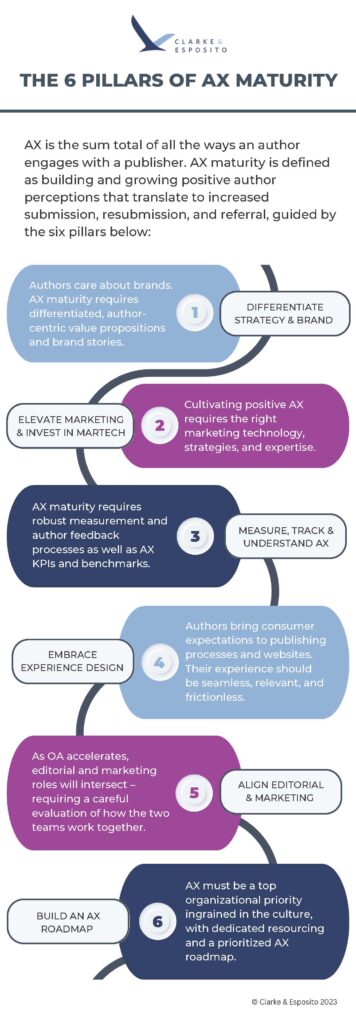MODERATOR:
Tricia Kershaw
Manager of Journals Production
American Society of Civil Engineers
@TJonesKershaw
SPEAKERS:
Colleen Scollans
Practice Lead Marketing and Customer Experience
Clarke & Esposito
@briefer_yet
Julia Kostova
Director of Publishing Development
Frontiers US
Romy Beard
Head of Publisher Relations
ChronosHub
@romybeard
REPORTER:
Becky Fargen
Journal Manager
Elsevier
How do we provide an excellent author experience (AX) when there are differing author and editor expectations, limited resources, and shifting publishing models? In this talk, 3 speakers presented tips on providing the ultimate AX—what to focus on, what tools are necessary, and why AX is important. There also was some focus on marketing, which greatly affects AX.
First, Colleen Scollans of Clarke & Esposito presented the Six Pillars of AX Maturity: (1) differentiate strategy and brand; (2) elevate marketing and invest in MarTech; (3) measure, track, and understand AX; (4) embrace experience design; (5) align editorial and marketing; and (6) build an AX roadmap (Figure). In this segment, the key takeaway was to listen to authors. Authors are often also readers, members, and board members, so demonstrating a positive customer experience and loyalty is important. Keeping things fast and simple and proving clear communication are helpful in putting authors first and ensuring that they have a positive experience.

Next, Julia Kostova of Frontiers discussed the holistic customer experience (CX) approach at her organization. Frontiers was founded by 2 researchers who were frustrated with their experiences with the existing publishing process, so the company was built with the researcher’s priorities in mind. Kostova pointed out that researchers interact with Frontiers in a variety of capacities—as authors, reviewers, editors, or readers—and as such, Frontiers’ approach to CX encompasses all of these journeys across the entire workflow, from presubmission through peer review and research integrity, through production to post-publication services like marketing. CX at Frontiers pivots around quality, intuitive and cutting-edge technology, timely and transparent communication, operational excellence, personalization; and a focus on metrics to allow for objective and consistent progress tracking.
Finally, Romy Beard of ChronosHub gave 5 tips for offering a better AX through workflow organization: (1) have one login for authors, (2) take time to decide what should be manual versus automated, (3) have a logical workflow sequence, (4) keep it simple, and (5) have a we-do-it-for-you attitude. One real-life example of how keeping it simple can pay off is Burbn, Instagram’s predecessor. This app was complex and had many features that were not useful, so it was rebranded as Instagram, and the rest is history. Beard talked about how it is important to think about what is automated, which can save time, versus what is manual, which adds a personal touch that can enhance the AX.
The importance of metrics and measuring the AX was also emphasized. In the Q&A, someone brought up the challenges of controlling the AX when outsourcing publishing to a third party. In this case, clarity, communication, and data are key. A happy author experience is usually better for everyone involved, so everyone should have the same goals.
Also, it is important to note that the AX includes rejected authors. All authors should have a positive experience, whether their paper is ultimately accepted or not. Authors often have a choice of many publications to submit to, and you want to provide the best experience if they decide to resubmit or refer their colleagues. Authors and their experience are more important today than ever before in the growing scholarly publishing community.
https://doi.org/10.36591/SE-D-4604-01
